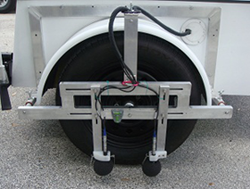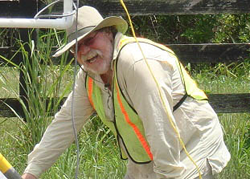Cutting-Edge Research Could Help Reduce Highway Noise
Finding a dream home and then hearing a loud highway just beyond the property line is a common complaint from potential home buyers. Staff at Volpe, The National Transportation Systems Center, are conducting research to understand how to reduce the amount of motor vehicle noise from roadways.
Noise created at the tire/pavement interface—the most significant contributor to passenger vehicle highway noise—has been the subject of an increasing level of research in the past decade due to the public's desire for quieter highways and communities. Research findings show that certain types of pavement help reduce noise. Determining the acoustic properties of different pavement types is important to identify which types are least noisy.
The on-board sound intensity (OBSI) method, the leading method in the U.S. for measuring tire/pavement noise at the source, uses microphones mounted near the tire/pavement interface. The conventional OBSI method uses acoustic monitoring equipment attached to an automobile with a test tire installed on the rear passenger side. Typically, measurements are performed while a test vehicle drives across different pavements. Volpe employs this method in efforts led by Dr. Judy Rochat, a prominent acoustic researcher in Volpe's Center for Environmental and Energy Systems. Dr. Rochat and her team are well-versed in conducting research using the conventional OBSI method and have performed various studies for state Departments of Transportation, the National Park Service, and the Federal Highway Administration.

As an alternate to the conventional OBSI method, Dr. Roger Wayson, engineer and principal technical advisor for environmental measurement and modeling, is leading a cutting-edge noise research study that features a special test rig attached to a trailer (instead of an automobile). Dr. Wayson is working with Dr. John MacDonald, a Volpe contractor, using this advanced method. The OBSI trailer method provides consistency of measurements over long time periods by controlling many specific variables. One such example is the weight on the tire.
The project sponsor, the Florida Department of Transportation, has been a key player in this work. This includes Bouzid Choubane, Patrick Upshaw, and Charles Holzschuher from the State Materials Office in Gainesville and Mariano Berrios from the Environmental Section in Tallahassee. Dr. Wayson and this team of professionals have designed and evaluated multiple test rigs and measurement systems over the past five years. The test rig is currently equipped with two sets of phase-matched microphones in a side-by-side, vertical configuration at the leading and trailing edges of the tire (these are considered the two principal locations for measuring tire/pavement interactions). Proper configuration of the equipment is important for obtaining accurate and comparable measurements. The data gathered using the OBSI method may then be used to compare the noise characteristics of different pavement surfaces, allowing the pavement textures and types to be ranked by the amount of sound generated at the tire/pavement interface.
According to Dr. Wayson, "We are working on how to use the OBSI information to predict sound levels at residences along the roadway. The successful implementation of the trailer mounted OBSI method has greatly helped the research by providing long-term consistency to measurement conditions, resulting in a superior database of pavement surface sound measurements."
If this new methodology can be proven to be accurate and reliable, the number of measurements typically taken on the side of the roadway to quantify roadway noise will be significantly reduced. Use of the OBSI method would save time, money, and headaches for transportation agencies.
Dr. Wayson believes that moving forward, the impact of this research will lead to more accurate predictive methods for noise along highways, reduce requirements for measurements, allow states to evaluate the existing pavement textures for noise control, and lead to the development of quieter pavement surfaces.
Photo above: The OBSI trailer method provides consistency of measurements over long time periods by controlling variables such as the weight on the tire. (Volpe photo)

Noise created at the tire/pavement interface—the most significant contributor to passenger vehicle highway noise—has been the subject of an increasing level of research in the past decade. (Photodisc photo)
Volpe Engineer Studies Noise and Air Pollution from Transportation Systems
 Dr. Roger Wayson is an engineer who supports multimodal projects focusing on the evaluation and abatement of noise and air pollution from transportation systems. Dr. Wayson's research focuses on community noise and air quality monitoring, modeling, and analysis.
Dr. Roger Wayson is an engineer who supports multimodal projects focusing on the evaluation and abatement of noise and air pollution from transportation systems. Dr. Wayson's research focuses on community noise and air quality monitoring, modeling, and analysis.Dr. Wayson is a licensed professional engineer in Tennessee and Florida. He is a member of the Air & Waste Management Association (AWMA), the Transportation Research Board, Society of Automotive Engineers, Acoustical Society of America, Institute of Noise Control Engineering, and American Society of Civil Engineers. He has been or is currently an officer in most of these organizations and is a fellow of the AWMA.
Prior to working at Volpe, Dr. Wayson was a professor on the faculty at the University of Central Florida (UCF). He joined UCF after completing his Ph.D. in civil engineering at Vanderbilt University and serving on the Vanderbilt faculty.
